การมีส่วนร่วมของชุมชนในการจัดการป่าผลิตเล่างาม จังหวัดสาละวัน สาธารณรัฐประชาธิปไตยประชาชนลาว
Main Article Content
บทคัดย่อ
การวิจัยครั้งนี้มีวัตถุประสงค์เพื่อศึกษา 1) สภาพเศรษฐกิจสังคมของประชาชนในชุมชนและการใช้ประโยชน์ทรัพยากรป่าไม้ในป่าผลิต 2) ระดับการมีส่วนร่วมและปัจจัยที่มีความสัมพันธ์กับการมีส่วนร่วมของประชาชนในการจัดการป่าผลิตเล่างาม กลุ่มตัวอย่างที่ใช้ในการวิจัยคือ ราษฎรที่อาศัยอยู่ในบ้านดงมอน และบ้านหนองโพ อำเภอวาปี จังหวัดสาละวัน จำนวน 121 คน เครื่องมือที่ใช้ในการวิจัยคือ แบบสัมภาษณ์ นำข้อมูลที่ได้มาประมวลผลด้วยเครื่องคอมพิวเตอร์โปรแกรมสำเร็จรูปทางสังคมศาสตร์ สถิติที่ใช้ในการวิจัยคือ ค่าความถี่ ค่าร้อยละ ค่าเฉลี่ย ส่วนเบี่ยงเบนมาตรฐาน และค่าทดสอบไคสแควร์ กำหนดค่านัยสำคัญทางสถิติที่ระดับ 0.05
ผลการวิจัยพบว่า ราษฎรที่ศึกษาเป็นเพศชาย อายุเฉลี่ย 43.20 ปี มีสถานภาพแต่งงานแล้ว จบการศึกษาระดับชั้นประถมศึกษา มีจำนวนสมาชิกในครัวเรือน เฉลี่ย 6 คน มีอาชีพหลักทำนา อาชีพรองคือรับจ้างทั่วไป รายได้รวมเฉลี่ย 26,357.02 บาทต่อปี รายจ่ายในครัวเรือนเฉลี่ย 24,158.93 บาทต่อปี สำหรับกิจกรรมที่ได้รับทุนส่งเสริมจากโครงการป่าผลิตคือ การเลี้ยงสัตว์ การถือครองพื้นที่ทำกินส่วนใหญ่มีที่ดินทำกินเป็นของตนเอง มีพื้นที่ทำกินเฉลี่ย 18.88 ไร่ต่อครัวเรือน การใช้ประโยชน์ที่ดินส่วนใหญ่เป็นการปลูกข้าว ปัญหาเกี่ยวกับการใช้ประโยชน์ที่ดินได้แก่ น้ำชลประทานไม่เพียงพอต่อการทำการเกษตร มีการตัดไม้จากป่ามาเพื่อก่อสร้างที่อยู่อาศัยและใช้สอยในครัวเรือน ปริมาณที่ใช้ในครัวเรือนเฉลี่ย 4.45 ลูกบาศก์เมตรต่อปี นอกจากนี้มีการเก็บหามาใช้เป็นเชื้อเพลิงเป็นปริมาณ 6 ลูกบาศก์เมตรต่อครัวเรือนต่อปี ราษฎรทุกรายมีการเก็บหน่อไม้ เก็บเห็ด ผักหวาน ผลไม้ป่า และแมลงกินได้ เป็นปริมาณ 38.77, 18.68,14.76, 9.62 และ 9.2 กิโลกรัมต่อครัวเรือนต่อปี ตามลำดับ ส่วนใหญ่มีรายได้เพิ่มขึ้นจากการเข้าร่วมโครงการ สำหรับปัญหาและอุปสรรคในการใช้ประโยชน์จากทรัพยากรป่าไม้ พบว่า ราษฎรที่ศึกษาประสบปัญหาในเรื่อง การลดลงของพื้นที่ป่าไม้และการลดลงของของป่า เช่น ผึ้ง หวาย สำหรับปัญหาและอุปสรรคในการมีส่วนร่วมจัดการป่าผลิตได้แก่ ชาวบ้านไม่มีเวลาเข้าร่วมกิจกรรม และให้ข้อเสนอแนะว่า ส่งเสริมการอนุรักษ์ให้กว้างขวางขึ้น และควรเผยแพร่ข้อมูลข่าวสารด้านป่าผลิต ผลการทดสอบสมมติฐานปัจจัยที่มีความสัมพันธ์กับการมีส่วนร่วมของประชาชนพบว่า เพศ และระดับการศึกษามีความสัมพันธ์กับระดับการมีส่วนร่วมในการจัดการป่าผลิตอย่างมีนัยสำคัญทางสถิติที่ระดับ 0.05
จากการศึกษาระดับการมีส่วนร่วมในการจัดการป่าผลิต พบว่าการมีส่วนร่วมในภาพรวมมีส่วนร่วมในการวางแผน ร้อยละ 63.83 มีส่วนร่วมในการ ดำเนินกิจกรรม ร้อยละ 59.41 มีส่วนร่วมในการ ติดตามประเมินร้อยละ 44.93
สำคัญ: การมีส่วนร่วมของชุมชน การจัดการป่าผลิต สาธารณรัฐประชาธิปไตยประชาชนลาว
Downloads
Article Details

อนุญาตภายใต้เงื่อนไข Creative Commons Attribution-NonCommercial-NoDerivatives 4.0 International License.
ข้าพเจ้าและผู้เขียนร่วม (ถ้ามี) ขอรับรองว่า ต้นฉบับที่เสนอมานี้ยังไม่เคยได้รับการตีพิมพ์และไม่ได้อยู่ในระหว่างกระบวนการพิจารณาตีพิมพ์ลงในวารสารหรือสิ่งตีพิมพ์อื่นใด ข้าพเจ้าและผู้เขียนร่วม (ถ้ามี) ยอมรับหลักเกณฑ์และเงื่อนไขการพิจารณาต้นฉบับ ทั้งยินยอมให้กองบรรณาธิการมีสิทธิ์พิจารณาและตรวจแก้ต้นฉบับได้ตามที่เห็นสมควร พร้อมนี้ขอมอบลิขสิทธิ์ผลงานที่ได้รับการตีพิมพ์ให้แก่วารสารวนศาสตร์ คณะวนศาสตร์ มหาวิทยาลัยเกษตรศาสตร์ กรณีมีการฟ้องร้องเรื่องการละเมิดลิขสิทธิ์เกี่ยวกับภาพ กราฟ ข้อความส่วนใดส่วนหนึ่ง หรือ ข้อคิดเห็นที่ปรากฏในผลงาน ให้เป็นความรับผิดชอบของข้าพเจ้าและผู้เขียนร่วม (ถ้ามี) แต่เพียงฝ่ายเดียว และหากข้าพเจ้าและผู้เขียนร่วม (ถ้ามี) ประสงค์ถอนบทความในระหว่างกระบวนการพิจารณาของทางวารสาร ข้าพเจ้าและผู้เขียนร่วม (ถ้ามี) ยินดีรับผิดชอบค่าใช้จ่ายทั้งหมดที่เกิดขึ้นในกระบวนการพิจารณาบทความนั้น”


